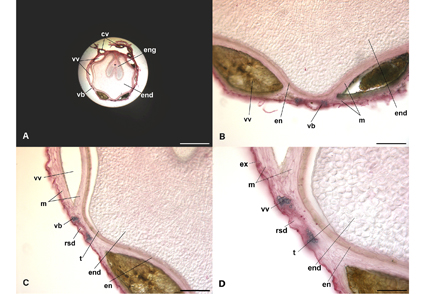Abstract
Echinophora scabra (Apiaceae) is one of the endemic species to the Iranica plateau with limited distribution range in Afghanistan and Pakistan which is the most eastern edge of the genus existence and penetration. In addition to its geographic distribution, morphologic, anatomic and micromorphologic characters of the plant, especially its umbellulas and mericarps features, make this species a remarkable candidate for further studies. Some of the most important and taxonomically valuable characters of its umbellulas and mericarps are: number of the male pedicels, absence of the sepals in umbellula’s central flower, petals shape, size of the sepals in male flowers, style length and indumentum, hypodermal collenchyma, relative size of the vascular bundles and vallecular vittae, width to thickness ratio of the endosperm, mericarp’s hair length and size of the platelets secretion on the mericarp surface. Here, we provided an emended taxonomic description improved with anatomical and micromorphological characters of the umbellulas and mericarps. Besides, we designated a lectotype and presented a comparison character table as well as a distribution map.
References
<p align="justify"><span style="color: #000000;"><span style="font-family: Times New Roman, serif;"><span style="font-size: small;">Breckle, S.W., Hedge, I.C. & Rafiqpoor, M.D. (2013) <em>Vascular Plants of Afghanistan: an Augmented Checklist</em>. Scientia Bonnensis, Bonn, Germany, 598 pp.</span></span></span></p>
<p align="justify"><span style="color: #000000;"><span style="font-family: Times New Roman, serif;"><span style="font-size: small;">Boissier, P.E. (1844) Plantae aucheranae. <em>Annales des Sciences Naturelles</em>, <em>Botanique</em> 3 (2): 87–94. </span></span></span></p>
<p align="justify"><span style="color: #000000;"><span style="font-family: Times New Roman, serif;"><span style="font-size: small;">De Candolle, A.P. (1829) <em>Collection de Mémoires pour servir à l’histoire du Règne végétal: Cinquième Mémoire: Sur la Famille des Ombellifères</em>. Treuttel et Würtz, Paris, 84 pp.</span></span></span></p>
<p align="justify"><span style="color: #000000;"><span style="font-family: Times New Roman, serif;"><span style="font-size: small;">Downie, S.R., Spalik, K., Katz-Downie, D.S. & Reduron, J.P. (2010) Major clades within Apiaceae subfamily Apioideae as inferred by phylogenetic analysis of nrDNA ITS sequences. <em>Plant Diversity and Evolution</em> 128 (1–2): 111–136. https://doi.org/10.1127/1869-6155/2010/0128-0005</span></span></span></p>
<p align="justify"><span style="color: #000000;"><span style="font-family: Times New Roman, serif;"><span style="font-size: small;">Gilli, A. (1959) Neue Umbelliferenaus Afghanistan. <em>Feddes Repertorium Specierum Novarum Regni Vegetabilis</em> 61: 193–194. https://doi.org/10.1002/fedr.19590610302</span></span></span></p>
<p align="justify"><span style="color: #000000;"><span style="font-family: Times New Roman, serif;"><span style="font-size: small;">Hedge, I.C. & Lamond, J.M. (1973) A Review of the Tribe Echinophoreae (Umbelliferae). <em>Notes from Royal Botanic Garden Edinburgh</em> 32 (2): 167–188.</span></span></span></p>
<p align="justify"><span style="color: #000000;"><span style="font-family: Times New Roman, serif;"><span style="font-size: small;">Hedge, I.C. & Lamond, J.M. (1987) <em>Umbelliferae</em>. <em>In</em>: Rechinger, K.H. (Ed.) <em>Flora Iranica</em> 162. Akademische Druck und Verlogsanstalt, Graz-Astria, pp. 65–82.</span></span></span></p>
<p align="justify"><span style="color: #000000;"><span style="font-family: Times New Roman, serif;"><span style="font-size: small;">Kljuykov, E.V., Liu, M., Ostromuva, T.A., Pimenov, M.G., Tilney, P.M. & Van Wyk, B.E. (2004) Toward a standardised terminology for taxonomically important morphological characters in the Umbelliferae. <em>South African Journal of Botany</em> 70 (3): 488–496. https://doi.org/10.1016/S0254-6299(15)30233-7</span></span></span></p>
<p align="justify"><span style="color: #000000;"><span style="font-family: Times New Roman, serif;"><span style="font-size: small;">Lindley, J. (1835) Notes upon some of the Himalayan Umbelliferae. <em>In</em>: Royle, J. F (Ed.) <em>Illustrations of the Botany and Other Branches of the Natural History of the Himalayan Mountains and of the Flora of Cashmere</em> 1. Wm. H. Allen and Co., London, pp. 232.</span></span></span></p>
<p align="justify"><span style="color: #000000;"><span style="font-family: Times New Roman, serif;"><span style="font-size: small;">Linnaeus, C. (1753) <em>Species PlantarumI</em>. Impensis Laurentii Salvii, Holmiæ [Stockholm], 560 pp.</span></span></span></p>
<p align="justify"><span style="color: #000000;"><span style="font-family: Times New Roman, serif;"><span style="font-size: small;">Mozaffarian, V. (2007) Umbelliferae. <em>In</em>: Assadi, M., Khatamsaz, M. & Maassoumi, A.A. (Eds.) <em>Flora of Iran</em> 54. Research Institute of Forests and Rangelands, Tehran, pp. 58–93.</span></span></span></p>
<p align="justify"><span style="color: #000000;"><span style="font-family: Times New Roman, serif;"><span style="font-size: small;">Nasir, E. (1972) <em>Umbelliferae. In: </em>Nasir, E. & Ali, S.I. (Eds.) <em>Flora of West Pakistan 20</em>. Stewart Herbarium, Gordon College, Rawalpindi, pp 1–168.</span></span></span></p>
<p align="justify"><span style="color: #000000;"><span style="font-family: Times New Roman, serif;"><span style="font-size: small;">Nasir, E. (2011) <em>Tropicos</em>. Missouri Botanical Garden. Available from: http://www.tropicos.org/Name/100328333 (accessed: 15 December 2022).</span></span></span></p>
<p align="justify"><span style="color: #000000;"><span style="font-family: Times New Roman, serif;"><span style="font-size: small;">Pimenov, M.G. & Leonov, M.V. (1993) <em>The Genera of Umbelliferae: A nomenclature</em>. Royal Botanic Gardens, Kew, London, 156 pp.</span></span></span></p>
<p align="justify"><span style="color: #000000;"><span style="font-family: Times New Roman, serif;"><span style="font-size: small;">POWO (2022) <em>Plants of the World Online</em>. Royal Botanic Gardens, Kew. Available from: http://www.plantsoftheworldonline.org (accessed: 10 December 2022).</span></span></span></p>
<p align="justify"><span style="color: #000000;"><span style="font-family: Times New Roman, serif;"><span style="font-size: small;">Takhtajan, A. (1997) <em>Diversity and classification of flowering plants</em>. Columbia University Press, New York, US, 643 pp.</span></span></span></p>
<p align="justify"><span style="color: #000000;"><span style="font-family: Times New Roman, serif;"><span style="font-size: small;">Takhtajan, A. (2009) <em>Flowering Plants</em>. Springer, Dordrecht, Netherlands, 871 pp. https://doi.org/10.1007/978-1-4020-9609-9</span></span></span></p>
<p align="justify"><span style="color: #000000;"><span style="font-family: Times New Roman, serif;"><span style="font-size: small;">Townsend, C.C. (1964) Notes on Umbelliferae of Iraq: I. <em>Kew Bulletin</em> 17 (3): 427–439. https://doi.org/10.2307/4113801</span></span></span></p>
<p align="justify"><span style="color: #000000;"><span style="font-family: Times New Roman, serif;"><span style="font-size: small;">Turland, N.J., Wiersema, J.H., Barrie, F.R., Greuter, W., Hawksworth, D.L., Herendeen, P.S., Knapp, S., Kusber, W.-H., Li, D.-Z., Marhold, K., May, T.W., McNeill, J., Monro, A.M., Prado, J., Price, M.J. & Smith, G.F. (2018) <em>International Code of Nomenclature for algae, fungi, and plants (Shenzhen Code) adopted by the Nineteenth International Botanical Congress Shenzhen, China, July 2018. </em>Regnum Vegetabile 159. https://doi.org/10.12705/Code.2018</span></span></span></p>


